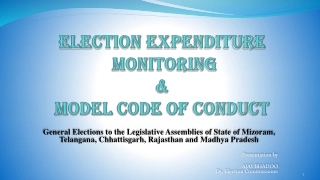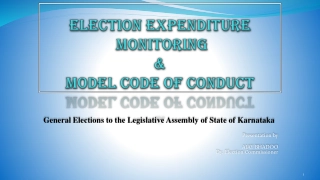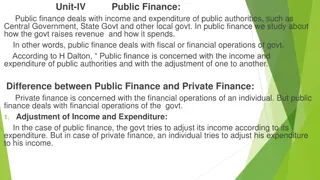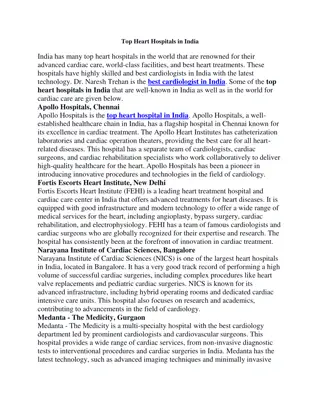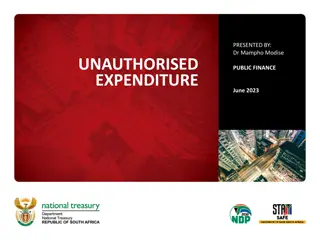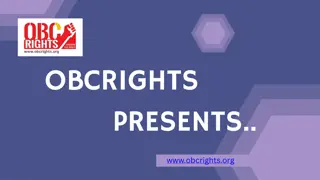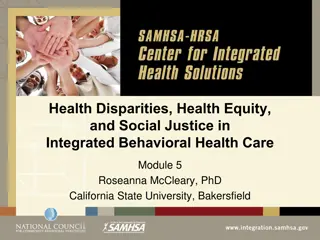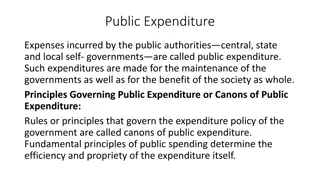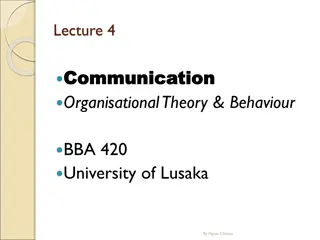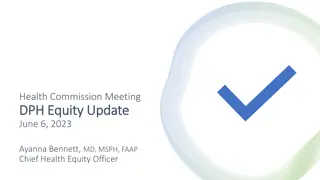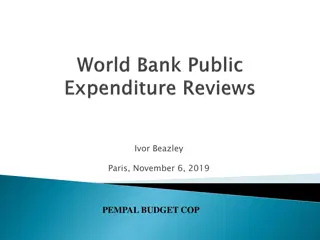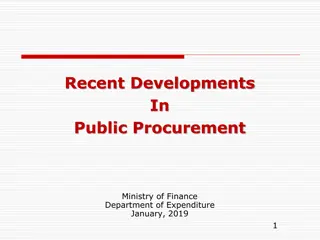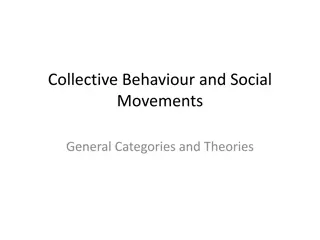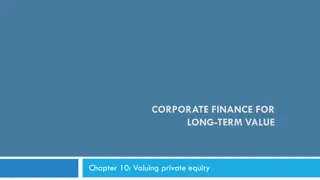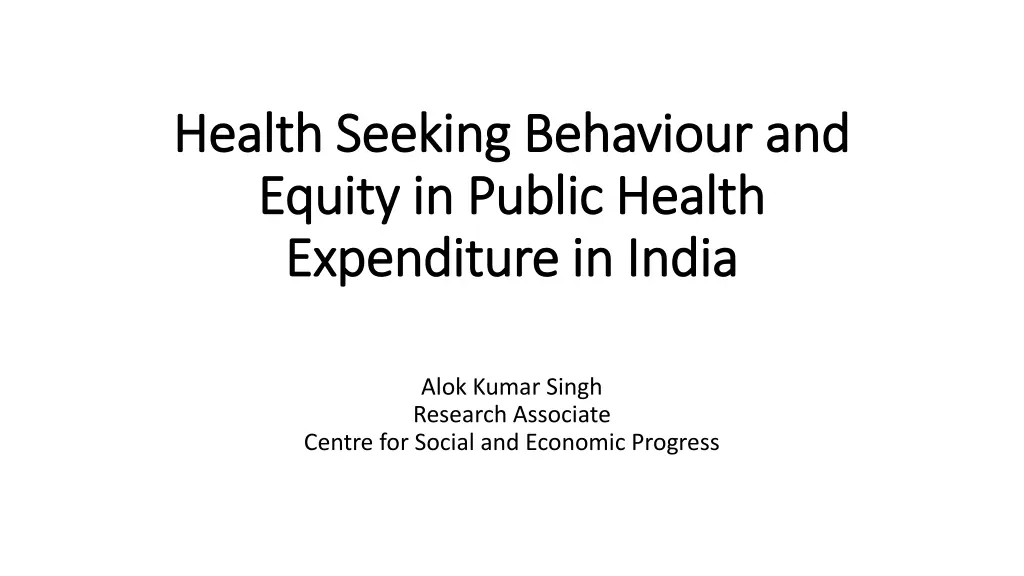
Understanding Health Seeking Behavior and Equity in Public Health Expenditure in India
Explore the determinants of health care utilization and out-of-pocket expenditure in India, analyzing government expenditure distribution across wealth groups. The study uses NSS 75th survey data and various statistical methods to assess financial protection and factors influencing health seeking behavior.
Download Presentation

Please find below an Image/Link to download the presentation.
The content on the website is provided AS IS for your information and personal use only. It may not be sold, licensed, or shared on other websites without obtaining consent from the author. If you encounter any issues during the download, it is possible that the publisher has removed the file from their server.
You are allowed to download the files provided on this website for personal or commercial use, subject to the condition that they are used lawfully. All files are the property of their respective owners.
The content on the website is provided AS IS for your information and personal use only. It may not be sold, licensed, or shared on other websites without obtaining consent from the author.
E N D
Presentation Transcript
Health Seeking Behaviour and Health Seeking Behaviour and Equity in Public Health Equity in Public Health Expenditure in India Expenditure in India Alok Kumar Singh Research Associate Centre for Social and Economic Progress
Background Background UHC model emphasis on financial protection Inequity in access to healthcare system (unmet needs of poorest quintile leading to forgone care) Unmet health care (outpatient) needs of the poorest quintile, 2018 Quintile Percentage of people utilized outpatient services, 2018 Burden of OOPE (% of APCE), 2018 Percentage of people paid for outpatient services 2018 Mean OOPE per spell of ailment (rs.), 2018 Percentage treated on medical advice 2018 Proportion of 1,000 people reported to be ill Govt Outpatient (total) 5.5% 5.3% 4.8% 4% 4.4% 4.8% Govt Private Total Govt 2014 2018 Poorest Poor Middle Rich Richest Total Source: Author s calculation using NSS 75th data 37 33 29 28 28 30 74 62 64 61 57 63 99 98 98 98 97 98 89 86 88 87 86 87 348 457 290 291 287 328 82 86 87 89 92 88 72 85 104 112 158 105 54 68 73 84 117 79 1. APCE: Annual Per Capita Consumer Expenditure 2. Proportion of people reported to be ill in the last 15 days
Research Objective To examine the distribution of govt expenditure across population groups (ranked by wealth) by assessing the extent to which financial protection and social & geographical factors drive health seeking behaviour Research Questions What are the determinants of health care utilization? What are the determinants of OOPE? How are the net benefits of government expenditure, linked with health care utilization and associated OOPE, distributed across population groups ranked by wealth?
Data and Methods Data and Methods NSS 75th survey data (Social Consumption on Health) Methods Measures of Association (Chi-Square, Cohen Power) Determinants of Utilization (Multilevel Regression, svyset design) Determinants of OOPE (Nonlinear OLS Regression, Heteroscedastic Regression) Government Expenditure Distribution (Benefit Incidence Analysis, Concentration Curve)
Health Care Utilization Health Care Utilization Reason for not availing government facility for inpatient care in 365 days before the survey, 2018 Reason for not availing government facility for outpatient in 15 days before the survey, 2018 Indicators Specific services not available Quality not satisfactory Poorest Poor 14.8 16.5 13.3 40.5 15.6 6.2 8.9 9.7 3.8 0.1 10.9 20.9 14.8 6.1 12.5 100 Middle 16.9 13.3 18.7 39.7 15.9 Rich 25.5 15.6 22.8 37.9 22.7 4.9 21 12.5 25.5 0.2 23.1 24.3 20.4 4.6 22.9 100 Richest Total 27.3 11.9 29.9 35.7 31.3 4.8 36.2 15.4 19.8 0.1 35.2 26.5 34.5 5.6 31.9 100 Indicator Specific services not available Quality not satisfactory Facility too far Poorest 13.3 8.3 10.9 25.6 19.8 20.3 9.5 14.3 36.4 1.6 8.9 22.9 14.6 7 11.6 100 Poor 14.9 6.9 15.8 27.3 19.1 14.5 15.5 17.1 12.6 0.4 14.9 28.3 15.4 5.5 15.8 100 Middle 17.5 7 17.5 26.1 19.1 12.5 20.2 19.3 19 0.5 17.3 28.5 20 6.2 18.3 100 Rich 19.1 6.3 22.2 27.2 21.1 11.3 21.2 16.5 20.5 0.5 23.6 31.7 26.1 6.6 22.3 100 Richest 35.2 8.1 33.5 28.5 20.9 7.8 33.6 18.3 11.4 0.2 35.3 32.9 23.9 4.2 32 100 Total 100 7 100 27 100 12 100 17 100 0.5 100 30 100 6 100 100 Row (%) Column (%) Row (%) Column (%) Row (%) Column (%) Row (%) Column (%) Row (%) Column (%) Row (%) Column (%) Row (%) Column (%) Row (%) Column (%) Row (%) Column (%) Row (%) Column (%) Row (%) Column (%) Row (%) Column (%) Row (%) Column (%) Row (%) Column (%) Row (%) Column (%) Row (%) Column (%) 15.5 14.7 15.2 39.3 14.4 4.8 15.1 13.9 29.6 0.5 12.9 21.1 16.3 5.7 14.7 100 100 14 100 38 100 Facility too far 4.4 18.7 14.2 21.4 0.3 17.9 24.1 13.9 5 100 14 100 0.2 100 24 100 Long waiting Long waiting Financial constraint Prefer trusted doc/hospital Financial constraint Prefer trusted doc/hospital Others Others 4 5 17.9 100 100 100 Total Total Source: Author s calculation using NSS 75th data
Determinants of Healthcare Utilization Determinants of Healthcare Utilization Inpatient Care Inpatient Care (1) public base outcome (2) private The probability of utilizing government facilities reduces with increase in wealth and upward social mobility The probability of utilizing government facilities for the poorest quintile is found to be 62% and 38% for richest quintile Presence of wealth index least influences the impact of social and geographical factors on health care (inpatient) utilization Variables 2. Geography (urban) 0.75*** (0.038) (-)0.33** (0.13) 0.23*** (0.047) (-)0.61*** (0.10) (-)0.42*** (0.083) 0.2*** (0.058) 0.38*** (0.061) 0.7*** (0.059) 1.12*** (0.060) (-)0.29*** (0.0386) -0.019*** (0.076) 91,449 2. Education (informal) 3. Education (formal) 2. Age (below 14 years) 3. Age (above 59 years) 2. Poor quintile(q2) 3. Middle (q3) 4. Rich (q4) 5. Richest (q5) 2. Gender (Female) Constant Observations 91,449 Standard errors in parentheses *** p<0.01, ** p<0.05, * p<0.1
Determinants of Healthcare Utilization Determinants of Healthcare Utilization Outpatient Care Outpatient Care (1) public base outcome (2) Private 0.29*** (0.069) (-)0.42* (0.25) (-)0.14* The probability of utilizing private facilities is higher (compared to inpatient care) irrespective of wealth quintile The Probability of utilizing government facilities by poorest quintile is found to be 35% and richest quintile is 27% Presence of wealth index least influences the impact of social and geographical factors on health care (outpatient) utilization Variables 2 Geography (urban) 2. Education (informal) 3. Education (till middle school) (0.076) 0.39*** 4. Education (secondary above) (0.089) 0.13 (0.14) (-)0.55*** (0.12) 0.19* (0.11) 0.39*** (0.11) 0.44*** (0.106) 0.49*** (0.10) 0.041 (0.052) 0.69*** (0.12) 39,342 2. Age (below 14 years) 3. Age (above 59 years) 2. Poor quintile(q2) 3. Middle (q3) 4. Rich (q4) 5. Richest (q5) 2. Gender (Female) Constant Observations 39,342 Standard errors in parentheses *** p<0.01, ** p<0.05, * p<0.1
Out of Pocket Expenditure Despite government health services being available at subsidized rates for the entire population at all levels of care, households nevertheless incur a considerable share of total consumer expenditure OOPE found to be regressive, and impoverishing Percentage of people paid for health care services (excluding non- medical expenditure), 2018 Quintile Percentage of people paid for outpatient services 2018 Percentage of people paid for inpatient services 2018 Govt 78 77 75 77 72 76 Percentage of people paid for inpatient and outpatient services 2018 Govt 76 70 70 69 63 69 Burden due to outpatient OOPE (% of APCE) Burden due to inpatient OOPE (% of APCE) Burden due to total OOPE (% of APCE) Govt Total Total Total Poorest Poor Middle Rich Richest Total 74 62 64 61 57 63 89 86 88 87 86 87 86 86 85 88 87 86 88 86 87 88 86 87 5.5 5.3 4.8 3.9 4.4 4.8 2.7 2.4 2.4 2.3 2.4 2.4 8 7.7 7.3 6 6.2 6.8 Source: Author s calculation using NSS 75th data
Determinants of OOPE Determinants of OOPE Inpatient Care Inpatient Care Regression Estimates: Factors Affecting Inpatient OOPE (public and private), 2018 Other than socio economic determinants, place of residence and type of provider plays significant role in determining OOPE Place of hospitalization is found to have statistically significant association with OOPE (1) (2) (3) (4) (5) (6) Variables Constant Education Age MPCE Geography (rural/ urban) Gender Coefficient Std. error 7.71*** (0.088) 0.06*** 0.15*** (0.017) 0.0001*** (9.57e-06) 0.24 *** (-)0.45*** (0.03) (0.01) (0.03) Observatio ns Insigma2 Std. error 79,612 79,612 79,612 79,612 79,612 79,612 1.03*** (0.02) Standard errors in parentheses *** p<0.01, ** p<0.05, * p<0.1
Determinants of OOPE Determinants of OOPE Outpatient Care Outpatient Care Regression Estimates: Factors affecting outpatient OOPE (public and private) Other than socio economic determinants, place of residence and type of provider plays significant role in determining OOPE Place of treatment is found to have statistically significant association with OOPE (1) (2) (3) (4) MPCE (5) (6) Gender Variables Constant Education Age Geography (rural/urban) Constant Std. error 5.36*** (0.083) (-)0.006 0.048*** 0 .00004** (0.02) (0.01) 0.13*** (0.04) (-)0.052* (0.03) (8.76e-06) Observations Insigma2 Std. error 36,960 0.43*** (0.02) 36,960 36,960 36,960 36,960 36,960 Standard errors in parentheses *** p<0.01, ** p<0.05, * p<0.1
Inequality in OOPE distribution by quintile and Inequality in OOPE distribution by quintile and facility facility Place of treatment in case of health need, 2018 NSS 75th survey data shows that a majority of services (both inpatient and outpatient) availed by those in the poorest quintile was in the urban area, and 12% of those in the poorest quintile using any service had to go to a different district to avail inpatient services. The variability in access, to an extent, explains differential cost of health care services, reinforced by the statistically significant relationship between the two Type of service Quintile Same district Within state different district Rural Other state Total Rural Urban Urban Inpatient Poorest Richest Poorest Richest 22 16 43 38 66 66 54 57 2 2 8 2 4 1 1 100 100 100 100 12 2 3 Outpatient 0.4 1 Source: Author s calculation using NSS 75th data
The variability in access and differential cost of health care for the households having similar purchasing power indicates that health care organization, especially in terms of the density of health centres, disproportionately favour those with higher purchasing power Assuming that the health centres have all the resources (medicine, diagnostics, and manpower) to deliver the required services Mean distance (in Km) of government health facilities from home, 2018 Quintile PHC Rural Govt hospitals Rural 23 17 24 21 27 22 Urban Urban Poorest Poor Middle Rich Richest Total 8 5 6 8 8 7 5 4 3 4 2 4 9 11 10 13 11 11 Source: LASI WAVE I, 2017-18
Benefit Incidence Analysis (BIA) Benefit Incidence Analysis (BIA) BIA for Inpatient Government (EAG) Quintile % distribution of population % share of OOPE Net Exp. (in crore) 62,004 Unit cost (in rs.) 59,652 Net Benefit (% distribution) % Total Utilization Poorest 20 27.1 34.7 34.3 Poor 20 19.9 21.9 21.8 Middle 20 20.4 20.2 20.2 Rich 20 15.9 13.8 13.9 Richest 20 100 16.8 100 9.4 100 9.8 100 Total
BIA for Inpatient BIA for Inpatient Government ( Government (NonEAG NonEAG) ) Quintile % distribution of population % share of OOPE Net Exp. (in crore) 100,190 Unit cost (in rs.) 88,874 Net Benefit (% distribution) % Total Utilization Poorest 20 9.8 11.7 11.7 Poor 20 16.2 17.1 17.0 Middle 20 17.8 22.8 22.6 Rich 20 25.2 24.5 24.5 Richest 20 100 31.0 100 23.9 100 24.2 100 Total
BIA for Inpatient Government (NE) Quintile % distribution of population % share of OOPE Net Exp. (in crore) 9,989 Unit cost (in rs.) 96,980 Net Benefit (% distribution) % Total Utilization Poorest 20 15.7 16.6 16.6 Poor 20 19.6 19.1 19.1 Middle 20 21.3 21.7 21.7 Rich 20 22.2 22.6 22.6 Richest 20 100 21.2 100 20.0 100 20.0 100 Total
BIA for Inpatient Total (National Estimate) Quintile % distribution of population % share of OOPE Net Exp. (in crore) Unit cost (in rs.) 50,371 Net Benefit (% distribution) % Total Utilization Poorest 172,121 20 10.7 20.1 17 Poor 20 14.2 18.3 17 Middle 20 18.0 20.4 20 Rich 20 21.6 20.9 21 Richest 20 100 35.5 100 20.2 100 25 100 Total Since percentage share of utilization is approximately same across all the quintiles, there is marginal difference in the benefits accrued across the quintiles as well. System seems to be more equal but it is problematic from health care needs perspective. E.g., 20% poorest population is getting 20.1% share of the total benefits, and 20% poor population is getting 18.3% of the total benefits.
Concentration curve for government subsidy on inpatient- total 100 Cumulative percentage of benefits/utilization 80 60 40 20 0 0 20 40 60 80 100 Cumulative population percentage Cumulative percentage of benefits Equality line Cumulative percentage utilization The concentration curve is just below the equality line. The overall health care system for inpatient care seems to be pro rich.
BIA for Inpatient - Government Quintile % distribution of population % share of OOPE Net Exp. (in crore) 86,494 Unit cost (in rs.) 38,234 Net Benefit (% distribution) % Total Utilization Poorest 20 18.0 22.5 22.1 Poor 20 18.2 19.5 19.4 Middle 20 19.1 21.6 21.4 Rich 20 20.5 19.4 19.5 Richest 20 100 24.1 100 17.0 100 17.6 100 Total Since percentage share of utilization is approximately same across all the quintiles, there is marginal difference in the benefits accrued across the quintiles as well. System seems to be more equal but it is problematic from health care needs perspective. E.g., 20% poorest population is getting 22.5% share of the total benefits, and 20% poor population is getting 19.4% of the total benefits.
Concentration curve for government subsidy on Inpatient- Public Hospital 100.0 Distribution of net benefits (%) 90.0 80.0 70.0 60.0 50.0 40.0 30.0 20.0 10.0 0.0 0.0 20.0 40.0 60.0 80.0 100.0 Cumulative population percentage Cumulative percentage of benefits Equality line Healthcare delivery (inpatient) seems to be pro poor as the concentration curve dominates the equality line.
BIA for Outpatient Government (EAG) Quintile % distribution of population % share of OOPE Net Exp. (in crore) 56,955 Unit cost (in rs.) 4,311 Net Benefit (% distribution) % Total Utilization Poorest 20 25.7 35.1 33.9 Poor 20 32.3 18.3 20.0 Middle 20 15.6 18.2 17.9 Rich 20 12.2 15.7 15.3 Richest 20 100 14.2 100 12.8 100 12.9 100 Total Note: Net expenditure is for the year, therefore, the net benefit distributed is for the year.
BIA for Outpatient Government (NonEAG) Quintile % distribution of population % share of OOPE Net Exp. (in crore) 94,578 Unit cost (in rs.) 2,643 Net Benefit (% distribution) % Total Utilization Poorest 20 10.1 9.4 9.5 Poor 20 15.9 16.3 16.3 Middle 20 15.5 17.4 17.3 Rich 20 23.9 22.2 22.3 Richest 20 100 34.6 100 34.7 100 34.7 100 Total Note: Net expenditure is for the year, therefore, the net benefit distributed is for the year.
BIA for Outpatient Government (NE) Quintile % distribution of population % share of OOPE Net Exp. (in crore) 9,500 Unit cost (in rs.) 12,622 Net Benefit (% distribution) % Total Utilization Poorest 20 11.0 17.5 17.0 Poor 20 43.3 27.7 29.0 Middle 20 18.0 28.4 27.5 Rich 20 9.9 16.1 15.6 Richest 20 100 17.8 100 10.3 100 10.9 100 Total Note: Net expenditure is for the year, therefore, the net benefit distributed is for the year.
BIA for Outpatient - Total Quintile % distribution of population % share of OOPE Net Exp. (in crore) NA Unit cost (in rs.) NA Net Benefit (% distribution) NA % Total Utilization Poorest 20 11.4 13 Poor 20 16.4 16 Middle 20 18.6 18 Rich 20 20.4 22 Richest 20 100 33.2 31 100 Total 100 Since the government does not cover outpatient care and the distribution of utilization is skewed towards richer population due to greater private utilization, the system will remain pro-rich until the cost of outpatient care is covered.
BIA for Outpatient - Government Quintile % distribution of population % share of OOPE Net Exp. (in crore) 116,747 Unit cost (in rs.) 2,365 Net Benefit (% distribution) % Total Utilization Poorest 20 17 15.9 16 Poor 20 25 16.6 18 Middle 20 16 17.9 18 Rich 20 18 20.6 20 Richest 20 100 25 100 29 100 28 100 Total Note: Net expenditure is for the year, therefore, the net benefit distributed is for the year.
Concentration curve for government subsidy on outpatient care- Government Facility Pro rich- Concentration curve below equality line. 100 90 Cumulative percentage benefits 80 70 60 50 40 30 20 10 0 0 20 40 60 80 100 Cumulative population percentage Cumulative percentage benefits Equality line
Discussion Discussion The analysis reveals that while the government inpatient system is largely equitable and pro-poor in benefits distribution, the outpatient one is not so, with benefits being pro-rich. Overall (public and private) health care system is found to be less equitable (cumulative utilization and benefits are more for q4 and q5) The benefits distribution analysis highlights the social and systems-related drivers of utilisation, health-related expenditure, and therefore benefits distribution (questions the emphasis of UHC model on financial protection) Choice of provider (and ultimately outpatient care utilization in general) is predominantly a function of age (a proxy for demographic change), MPCE (a proxy for financial protection), and type of provider & geography (a proxy for health care systems) Need to incorporate nonfinancial factors (health system related) in UHC model
Dimensions of Dimensions of the Health the Health System to Be System to Be Considered to Considered to Achieve UHC Achieve UHC

